Create DNS records at 1&1 Internet for Office 365
Check the Domains FAQ if you don't find what you're looking for.
Caution:
-
Note that 1&1 Internet doesn't allow a domain to have both an MX record and a top-level Autodiscover CNAME record. This limits the ways in which you can configure Exchange Online for Office 365. There is a workaround, but we recommend employing it only if you already have experience with creating subdomains at 1&1 Internet.
-
If despite this service limitation you choose to manage your own Office 365 DNS records at 1&1 Internet, follow the steps in this article to verify your domain and to set up DNS records for email, Skype for Business Online, and so on.
These are the main records to add. Follow the steps below or watch the video(Need more help? Get support.)
After you add these records at 1&1 Internet, your domain will be set up to work with Office 365 services.
To learn about webhosting and DNS for websites with Office 365, see Use a public website with Office 365.
Note: Typically it takes about 15 minutes for DNS changes to take effect. However, it can occasionally take longer for a change you've made to update across the Internet's DNS system. If you're having trouble with mail flow or other issues after adding DNS records, see Troubleshoot issues after changing your domain name or DNS records.
Add a TXT record for verification
Before you use your domain with Office 365, we have to make sure that you own it. Your ability to log in to your account at your domain registrar and create the DNS record proves to Office 365 that you own the domain.
Note: This record is used only to verify that you own your domain; it doesn't affect anything else. You can delete it later, if you like.
Follow the steps below or watch the video (start at 0:42).
-
To get started, go to your domains page at 1&1 Internet by using this link. You'll be prompted to login.
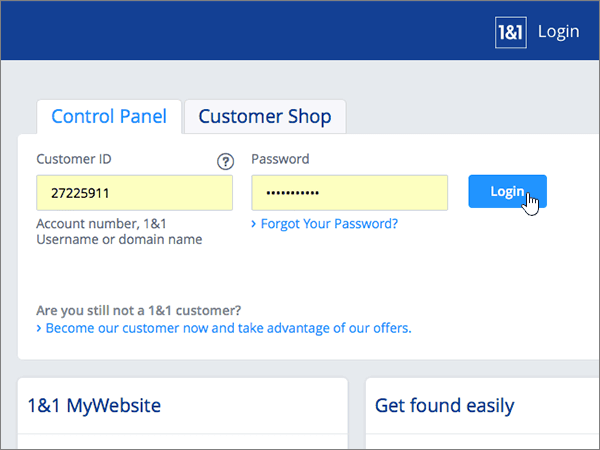
-
Choose Manage domains.
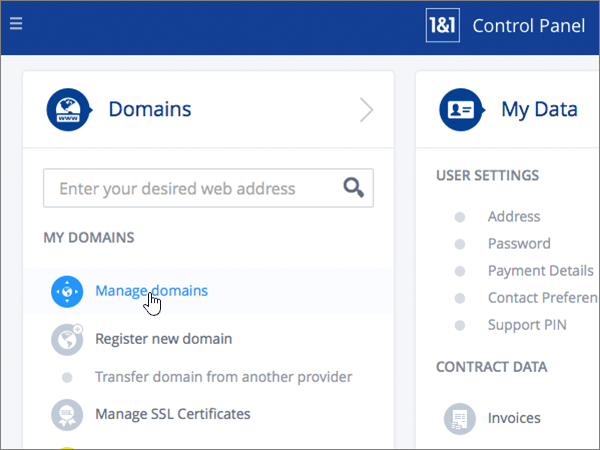
-
On the Domain Center page, find the domain that you want to update, and then choose the Panel (v) control for that domain.
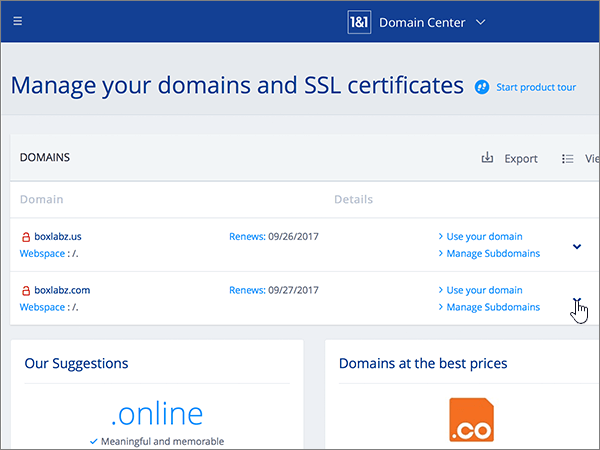
-
In the Domain Settings area, choose Edit DNS Settings.
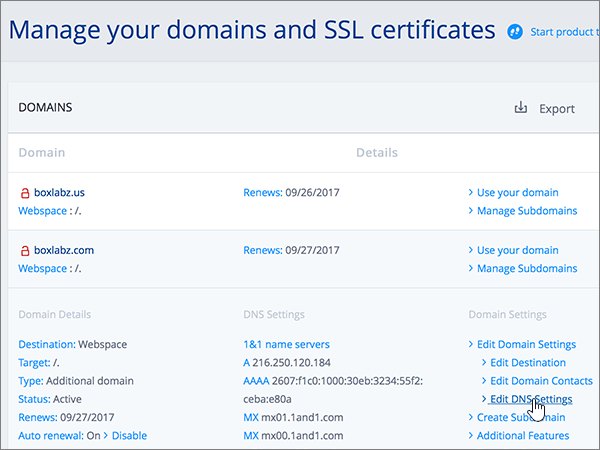
-
In the TXT and SRV Records section, choose Add Record.
(You may have to scroll down.)
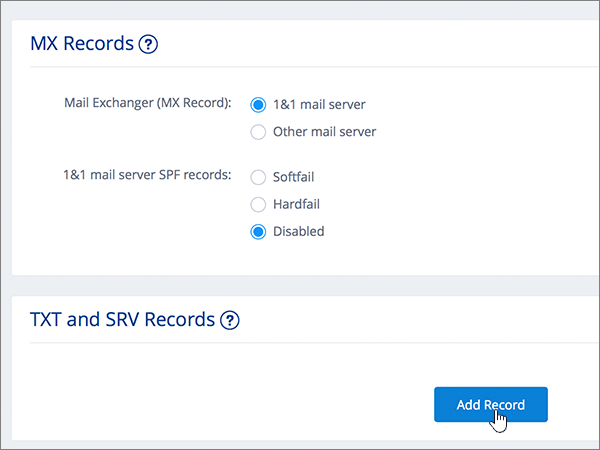
-
In the Add Record area, in the boxes for the new record, type or copy and paste the values from the following table.
(Select the Type value from the drop-down list.)
Type
Prefix
Name Value
TXT
(Leave this field empty.)
MS=msXXXXXXXX
Note: This is an example. Use your specific Destination or Points to Address value here, from the table in Office 365.
How do I find this?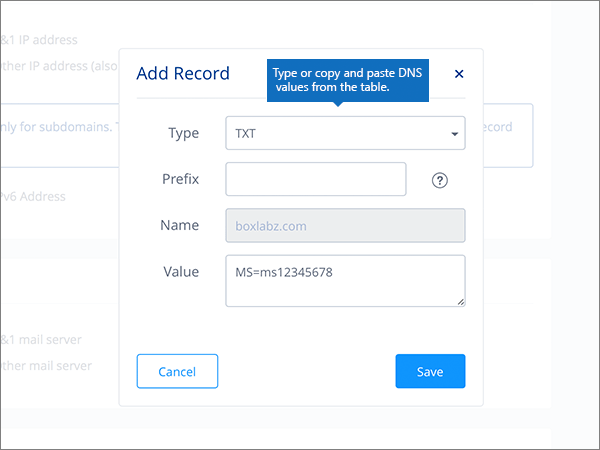
-
Choose Save.
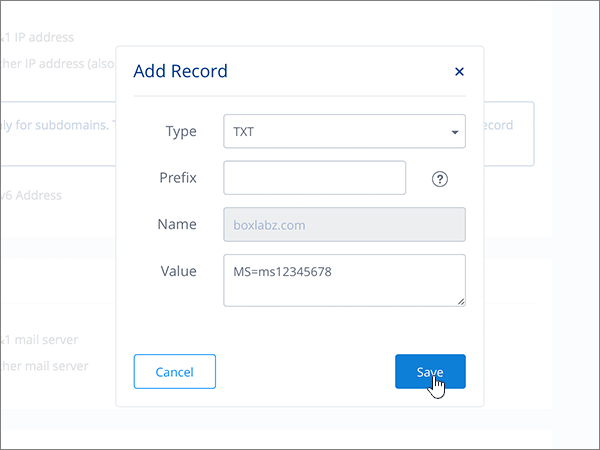
-
Choose Save.
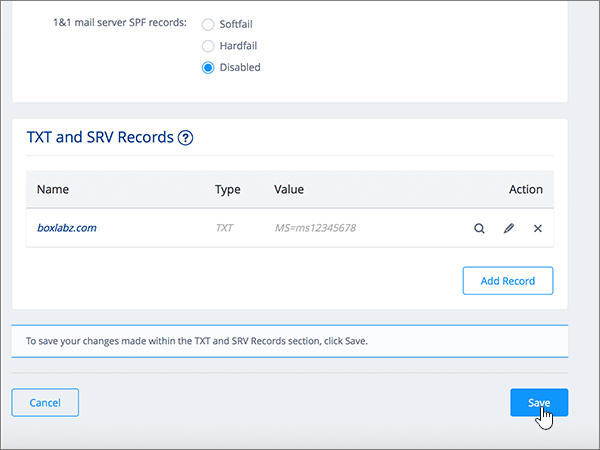
-
In the Edit DNS Settings dialog box, choose Yes.
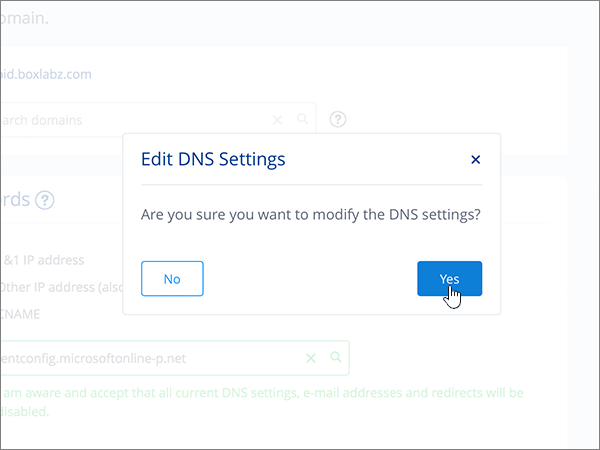
-
Wait a few minutes before you continue, so that the record you just created can update across the Internet.
Now that you've added the record at your domain registrar's site, you'll go back to Office 365 and request Office 365 to look for the record.
When Office 365 finds the correct TXT record, your domain is verified.
-
On the Domains page, choose the domain that you are verifying.
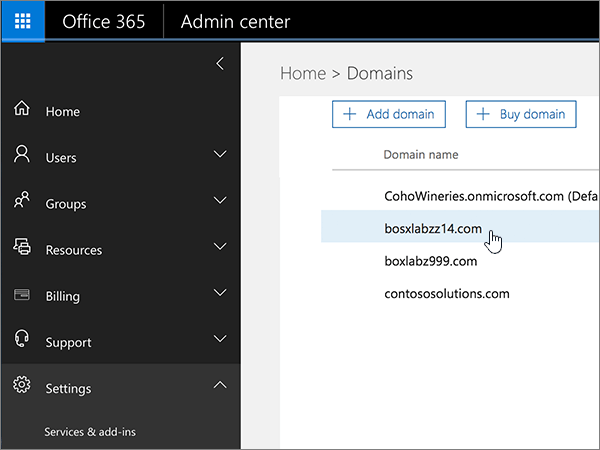
-
On the Setup page, choose Start setup.
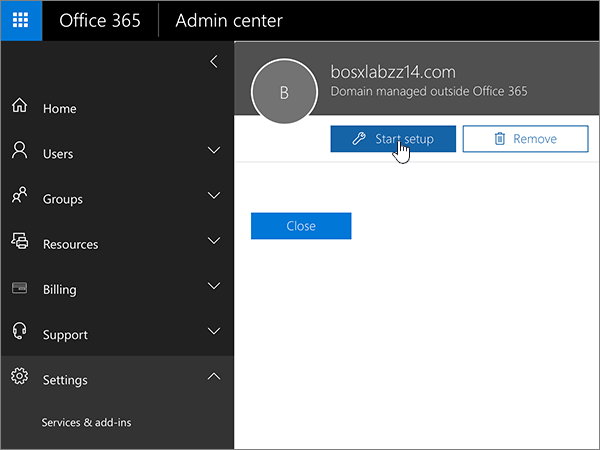
-
On the Verify domain page, choose Verify.
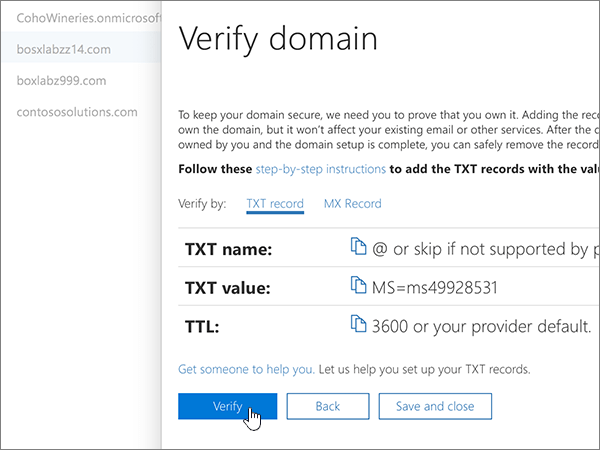
Note: Typically it takes about 15 minutes for DNS changes to take effect. However, it can occasionally take longer for a change you've made to update across the Internet's DNS system. If you're having trouble with mail flow or other issues after adding DNS records, see Troubleshoot issues after changing your domain name or DNS records.
Add an MX record so email for your domain will come to Office 365
Follow the steps below or watch the video (start at 3:22).
Note: If you've registered with 1und1.de, sign in here.
-
To get started, go to your domains page at 1&1 Internet by using this link. You'll be prompted to login.

-
Choose Manage domains.

-
On the Domain Center page, find the domain that you want to update, and then choose the Panel (v) control for that domain.

-
In the Domain Settings area, choose Edit DNS Settings.

-
In the MX Records section, in the Mail Exchanger (MX Record) area, select Other mail server.
(You may have to scroll down.)
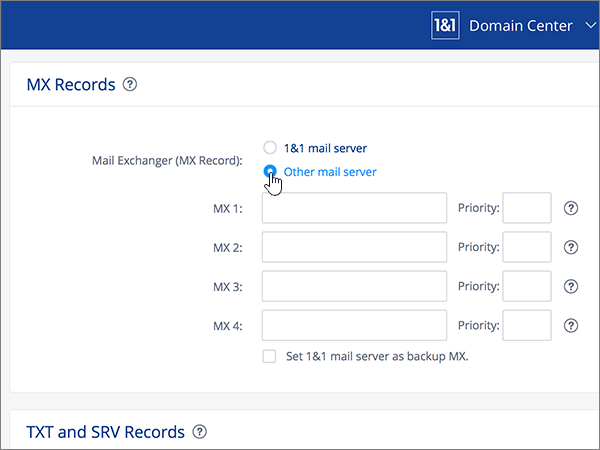
-
If there are any MX records already listed, delete each of them by selecting the record and then pressing the Delete key on your keyboard.
(If there are no MX records already listed, continue to the next step.)
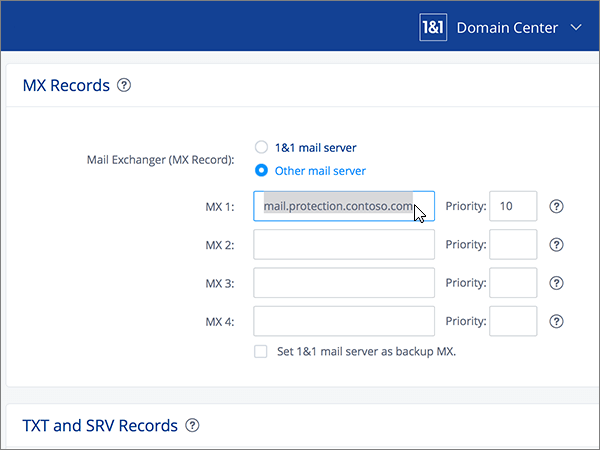
-
In the boxes for the MX 1 record, type or copy and paste the values from the following table.
MX 1
Priority
<domain-key>.mail.protection.outlook.com
Note: Get your <domain-key> from your Office 365 portal account.
How do I find this?10
For more information about priority, see What is MX priority?
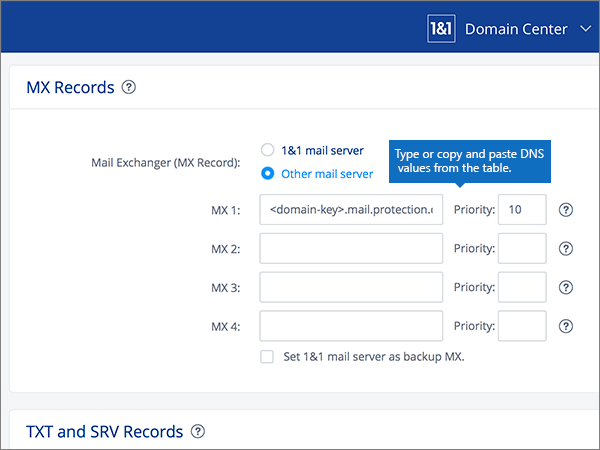
-
Choose Save.
(You may have to scroll down.)
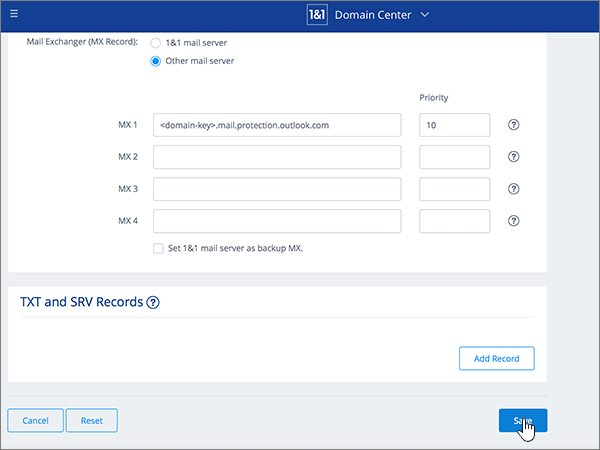
-
In the Edit DNS Settings dialog box, choose Yes.

Add the six CNAME records that are required for Office 365
1&1 Internet requires a workaround so that you can use an MX record together with the CNAME records that are required for Office 365 email services. This workaround requires you to create a set of subdomains at 1&1 Internet, and to assign them to CNAME records.
Important: Make sure that you have at least two available subdomains before starting this procedure. We recommend this solution only if you already have experience with creating subdomains at 1&1 Internet.
Basic CNAME records
Follow the steps below or watch the video (start at 3:57).
Note: If you've registered with 1und1.de, sign in here.
-
To get started, go to your domains page at 1&1 Internet by using this link. You'll be prompted to login.

-
Choose Manage domains.

-
On the Domain Center page, find the domain that you want to update and then choose Manage Subdomains.
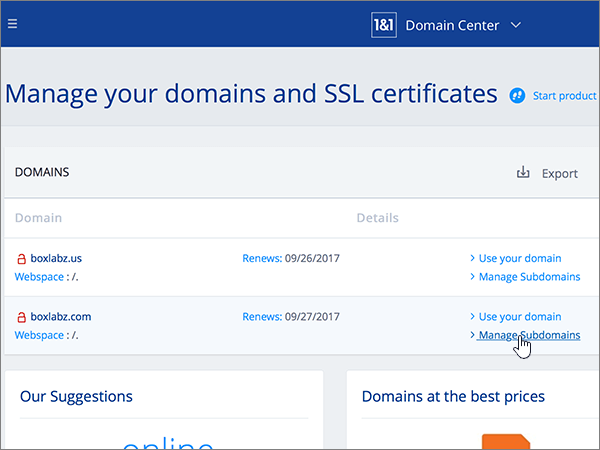
Now you'll create two subdomains and set an Alias value for each.
(This is required because 1&1 Internet supports only one top-level CNAME record, but Office 365 requires several CNAME records.)
First, you'll create the Autodiscover subdomain.
-
In the Subdomain Overview section, choose Create Subdomain.
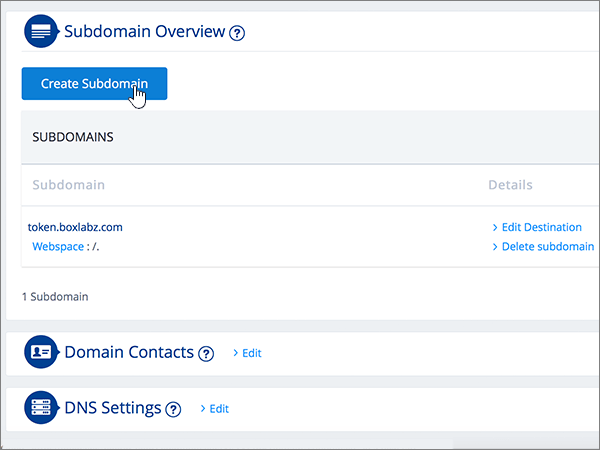
-
In the Create Subdomain box for the new subdomain, type or copy and paste only the Create Subdomain value from the following table. (You'll add the Alias value in a later step.)
Create Subdomain
Alias
autodiscover
autodiscover.outlook.com
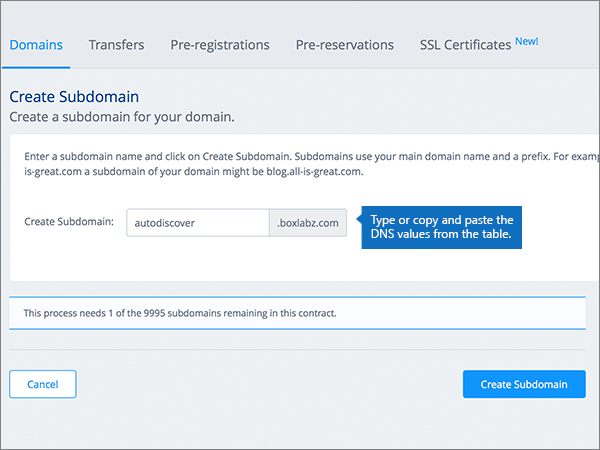
-
Choose Create Subdomain.
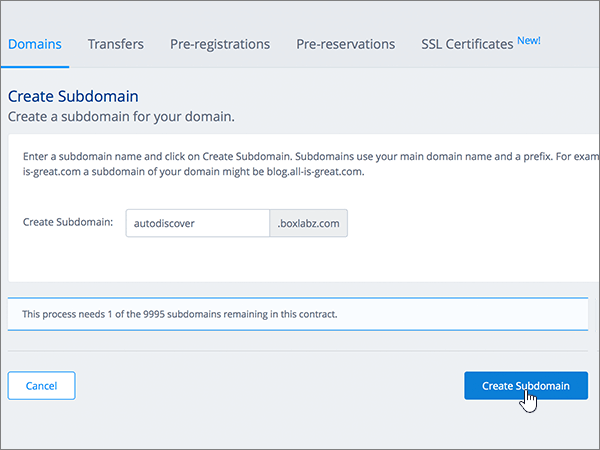
-
In the Subdomain Overview section, locate the autodiscover subdomain that you just created, and then choose the Panel (v) control for that subdomain.
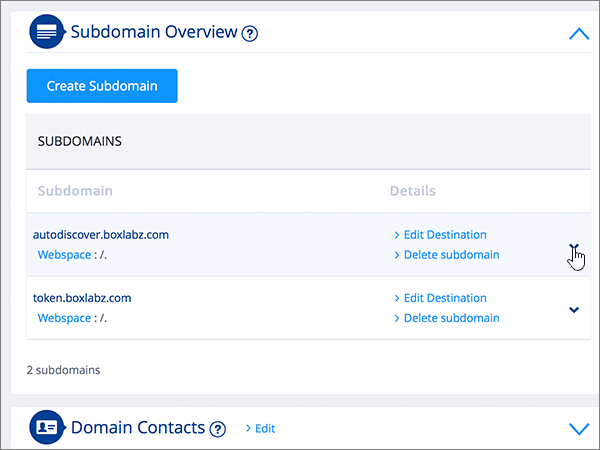
-
In the Subdomain Settings area, choose Edit DNS Settings.
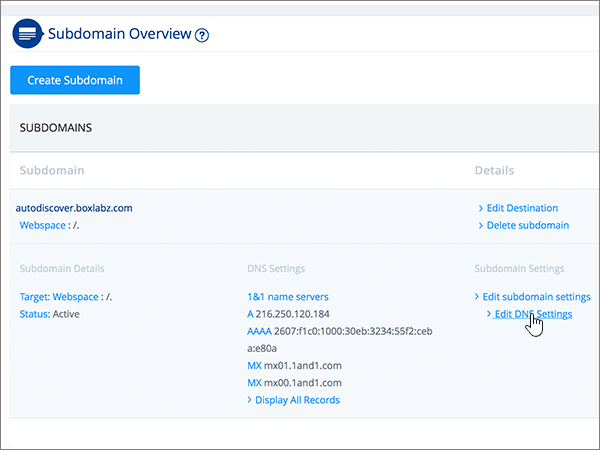
-
In the A/AAAA Records (IP Addresses) section, in the IP address (A Record) area, select CNAME.
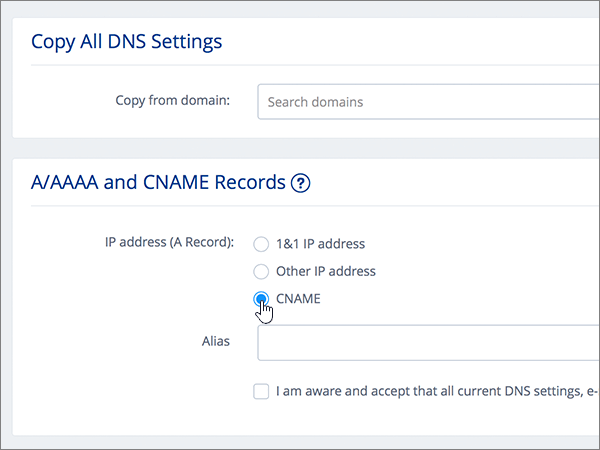
-
In the Alias: box, type or copy and paste only the Alias value from the following table.
Create Subdomain
Alias
autodiscover
autodiscover.outlook.com
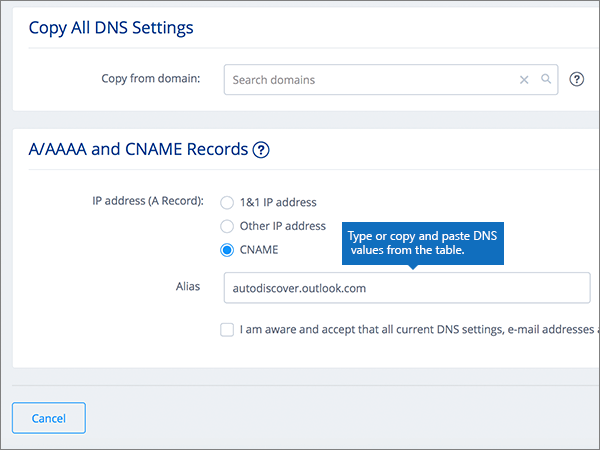
-
Select the check box for the I am aware disclaimer.
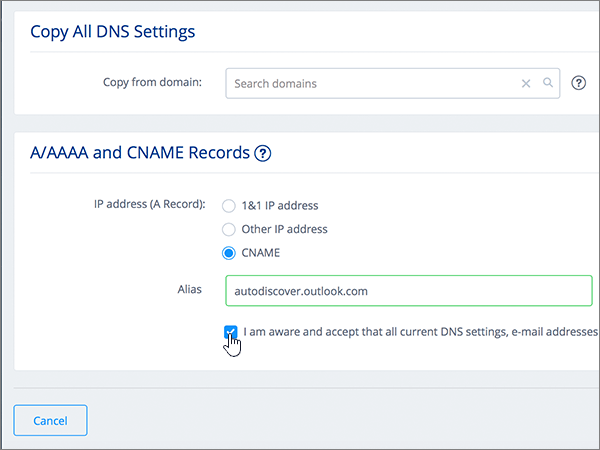
-
Choose Save.
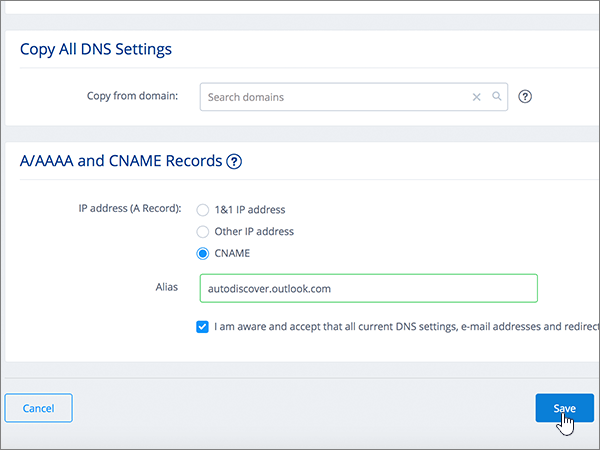
-
In the Edit DNS Settings dialog box, choose Yes.

Now you'll create the second subdomain.
-
In the Subdomain Overview section, choose Create Subdomain.
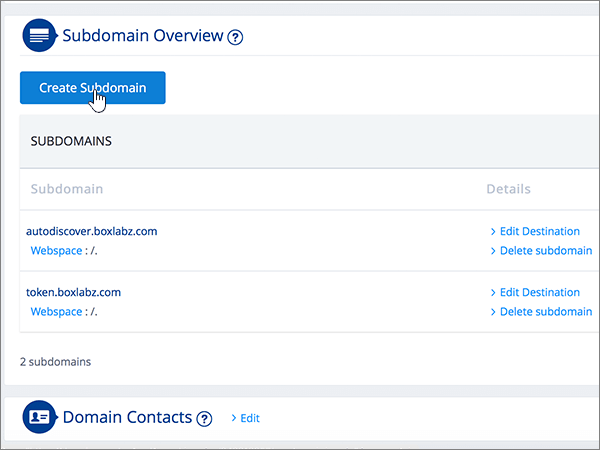
-
In the Create Subdomain box for the new subdomain, type or copy and paste only the Create Subdomain value from the following table. (You'll add the Alias value in a later step.)
Create Subdomain
Alias
msoid
clientconfig.microsoftonline-p.net
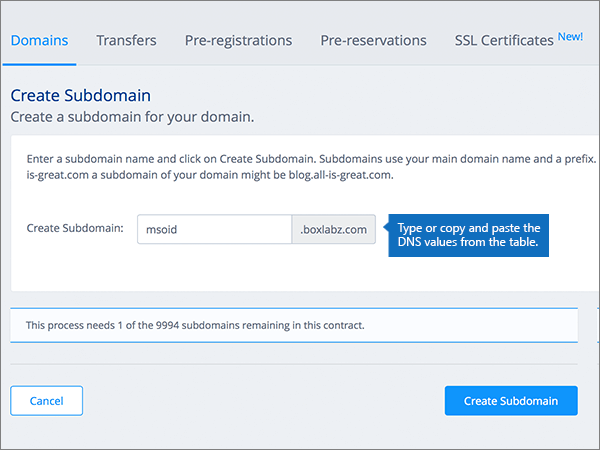
-
Choose Create Subdomain.
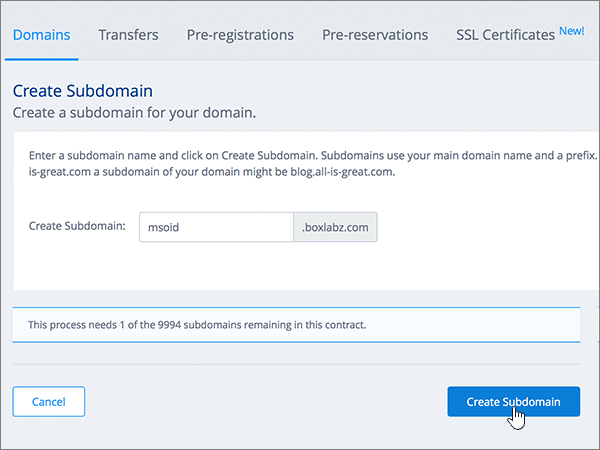
-
In the Subdomain Overview section, find the msoid subdomain that you just created, and then choose the Panel (v) control for that subdomain.
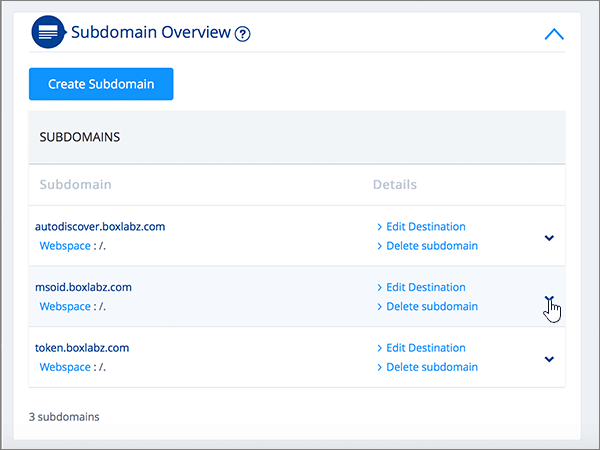
-
In the Subdomain Settings area, choose Edit DNS Settings.
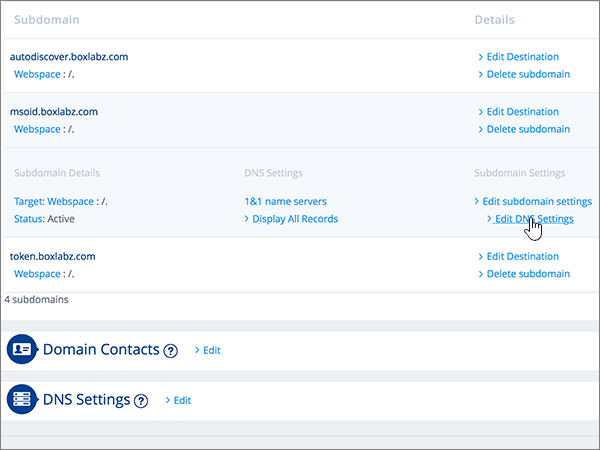
-
In the A/AAAA Records (IP Addresses) section, in the IP address (A Record) area, select CNAME.
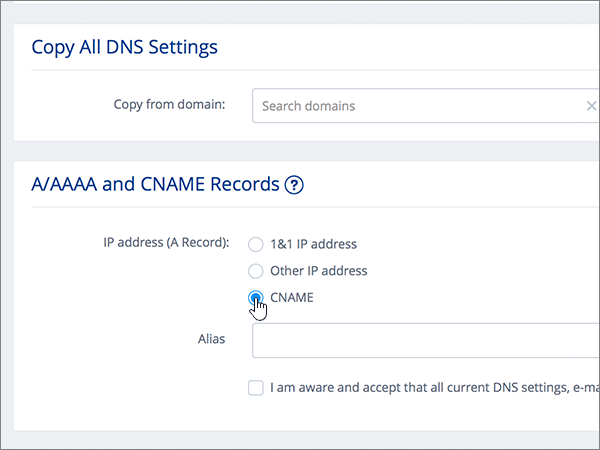
-
In the Alias: box, type or copy and paste only the Alias value from the following table.
Create Subdomain
Alias
msoid
clientconfig.microsoftonline-p.net
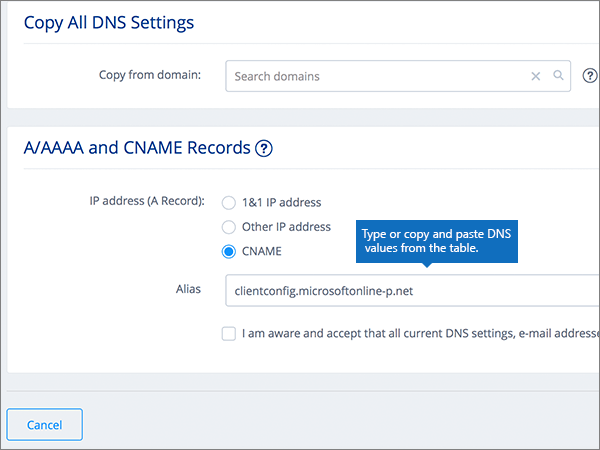
-
Select the check box for the I am aware disclaimer.
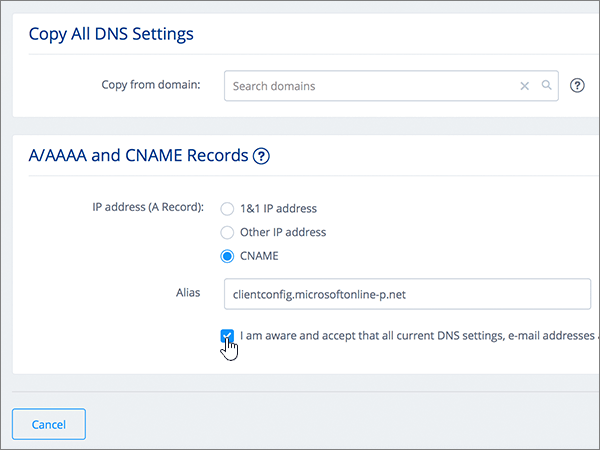
-
Choose Save.
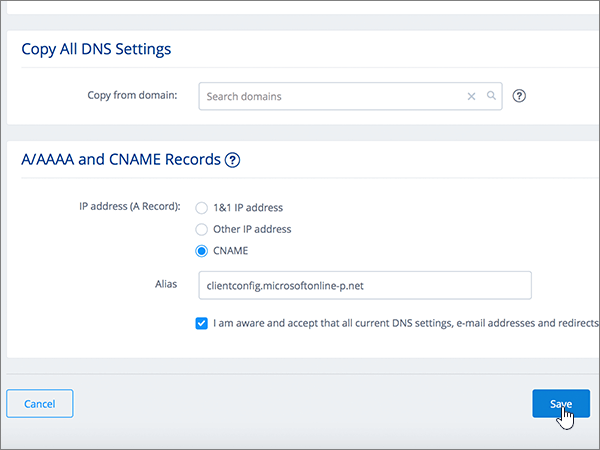
-
In the Edit DNS Settings dialog box, choose Yes.

Additional CNAME records
The additional CNAME records created in the following procedure enable Skype for Business Online services. You will employ the same steps that you used to create the two CNAME records you have already created.
-
Create the third subdomain (Lyncdiscover).
On the Subdomain Overview section, choose Create Subdomain.
-
In the Create Subdomain box for the new subdomain, type or copy and paste only the Create Subdomain value from the following table. (You'll add the Alias value in a later step.)
Create Subdomain
Alias
lyncdiscover
webdir.online.lync.com
-
Choose Create Subdomain.
-
On the Domain Center page, choose Manage Subdomains.
-
In the Subdomain Overview section, find the lyncdiscover subdomain that you just created, and then choose the Panel (v) control for that subdomain.
In the Subdomain Settings area, choose Edit DNS Settings.
-
In the A/AAAA Records (IP Addresses) section, in the IP address (A Record) area, select CNAME.
-
In the Alias: box, type or copy and paste only the Alias value from the following table.
Create Subdomain
Alias
lyncdiscover
webdir.online.lync.com
-
Select the check box for the I am aware disclaimer, and then choose Save.
-
In the Edit DNS Settings dialog box, choose Yes.
-
Create the fourth subdomain (SIP):
In the Subdomain Overview section, choose Create Subdomain.
-
In the Create Subdomain box for the new subdomain, type or copy and paste only the Create Subdomain value from the following table. (You'll add the Alias value in a later step.)
Create Subdomain
Alias
sip
sipdir.online.lync.com
-
Choose Create Subdomain.
-
On the Domain Center page, choose Manage Subdomains.
-
In the Subdomain Overview section, find the sip subdomain that you just created, and then choose the Panel (v) control for that subdomain.
In the Subdomain Settings area, choose Edit DNS Settings.
-
In the A/AAAA Records (IP Addresses) section, in the IP address (A Record) area, select CNAME.
-
In the Alias: box, type or copy and paste only the Alias value from the following table.
Create Subdomain
Alias
sip
sipdir.online.lync.com
-
Select the check box for the I am aware disclaimer, and then choose Save.
-
In the Edit DNS Settings dialog box, choose Yes.
CNAME records needed for MDM
Important: Follow the procedure that you used for the other four CNAME records, but supply the values from the following table.
| Create Subdomain | Alias |
|---|---|
| enterpriseregistration | enterpriseregistration.windows.net |
| enterpriseenrollment | enterpriseenrollment.manage.microsoft.com |
Add a TXT record for SPF to help prevent email spam
Important: You cannot have more than one TXT record for SPF for a domain. If your domain has more than one SPF record, you'll get email errors, as well as delivery and spam classification issues. If you already have an SPF record for your domain, don't create a new one for Office 365. Instead, add the required Office 365 values to the current record so that you have a single SPF record that includes both sets of values. Need examples? Check out these details and sample SPF records. To validate your SPF record, you can use one of these SPF validation tools.
Follow the steps below or watch the video (start at 5:09).
Note: If you've registered with 1und1.de, sign in here.
-
To get started, go to your domains page at 1&1 Internet by using this link. You'll be prompted to login.

-
Choose Manage domains.

-
On the Domain Center page, find the domain that you want to update, and then choose the Panel (v) control for that domain.

-
In the Domain Settings area, choose Edit DNS Settings.

-
In the TXT and SRV Records section, choose Add Record.
(You may have to scroll down.)

-
In the Add Record area, in the boxes for the new record, type or copy and paste the values from the following table.
(Select the Type value from the drop-down list.)
Type
Prefix
Name Value
TXT
(Leave this field empty.)
v=spf1 include:spf.protection.outlook.com -all
Note: We recommend copying and pasting this entry, so that all of the spacing stays correct.
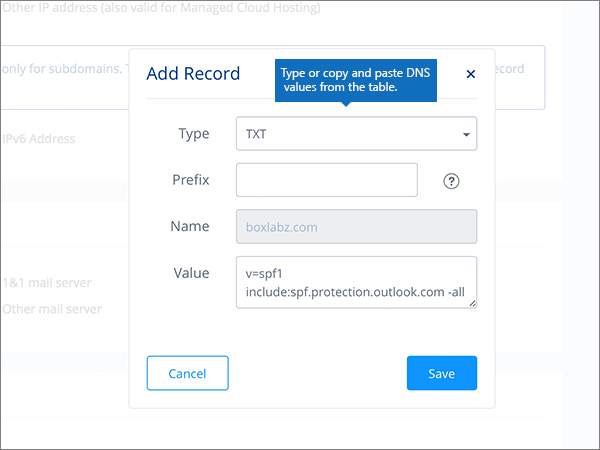
-
Choose Save.
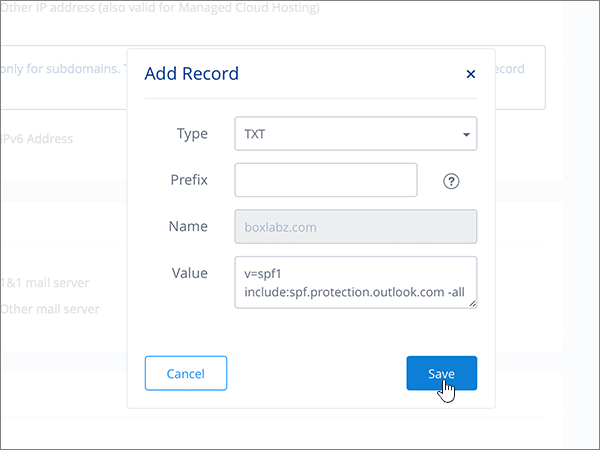
-
Choose Save.
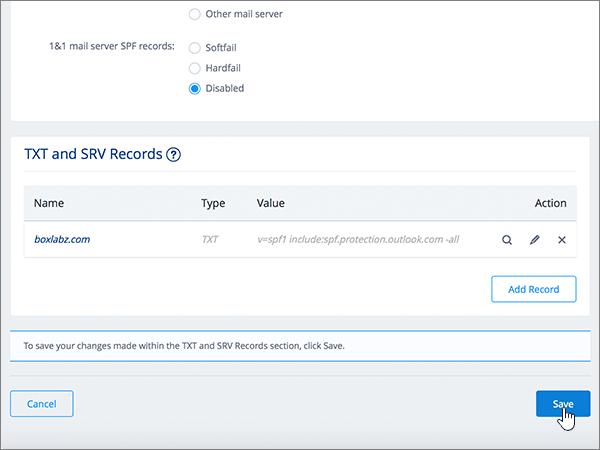
-
In the Edit DNS Settings dialog box, choose Yes.

Add the two SRV records that are required for Office 365
Follow the steps below or watch the video (start at 5:51).
Note: If you've registered with 1und1.de, sign in here.
-
To get started, go to your domains page at 1&1 Internet by using this link. You'll be prompted to login.

-
Choose Manage domains.

-
On the Domain Center page, find the domain that you want to update, and then choose the Panel (v) control for that domain.

-
In the Domain Settings area, choose Edit DNS Settings.

-
In the TXT and SRV Records section, choose Add Record.
(You may have to scroll down.)

-
Add the first of the two SRV records.
In the Add Record area, in the boxes for the new record, type or copy and paste the values from the first row in the following table.
(Select the Type and TTL values from the drop-down list.)
Type
Service
Protocol
Name
Host
Priority
Weight
Port
TTL
SRV
sip
tls
(Leave this field empty.)
sipdir.online.lync.com
100
1
443
3600 (1 h)
SRV
sipfederationtls
tcp
(Leave this field empty.)
sipfed.online.lync.com
100
1
5061
3600 (1 h)
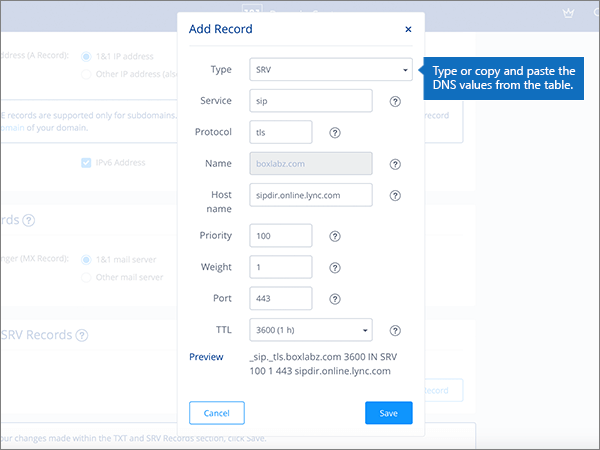
-
Choose Save.
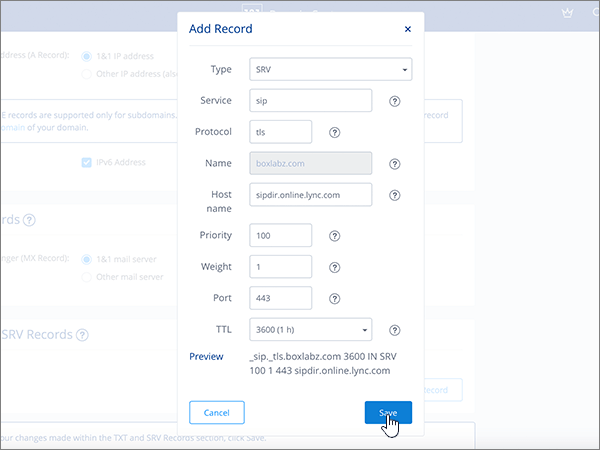
-
Choose Save.
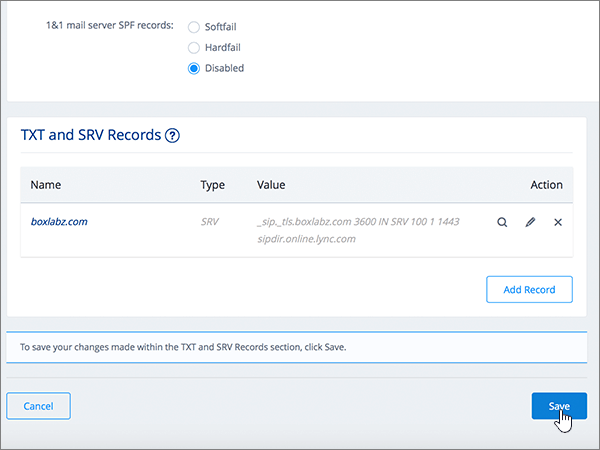
-
In the Edit DNS Settings dialog box, choose Yes.

-
Add the other SRV record.
In the TXT and SRV Records section, choose Add Record.
In the Add Record area, create a record using the values from the other row in the table, and then again choose Add, Save, and Yes to complete the record.
Note: Typically it takes about 15 minutes for DNS changes to take effect. However, it can occasionally take longer for a change you've made to update across the Internet's DNS system. If you're having trouble with mail flow or other issues after adding DNS records, see Troubleshoot issues after changing your domain name or DNS records.
Still need help?




Thanks for posting this article. Its Very Unique!!
ReplyDeleteCarbonite
SD-WAN LANCOM
Logiciel de sauvegarde pas cher